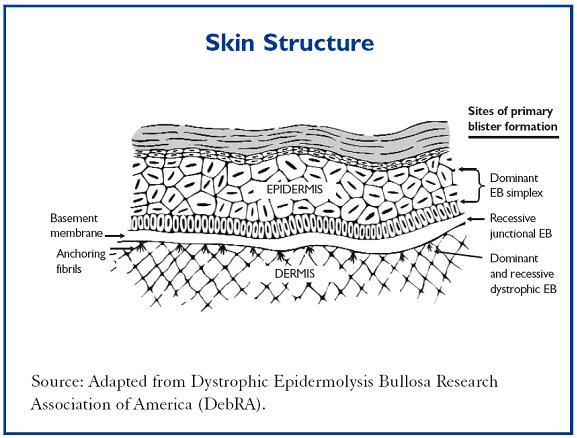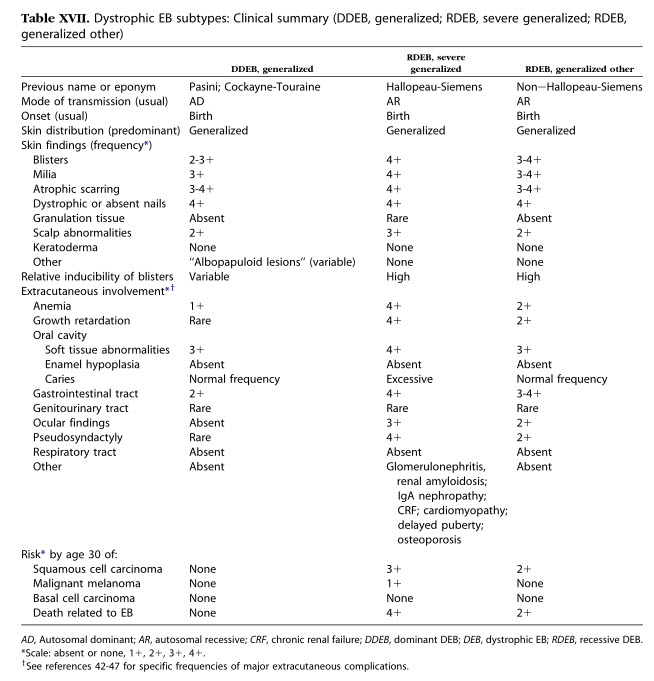Epidermolysis Bullosa
Revision as of 08:24, 16 September 2011 by User:Fellrnr (User talk:Fellrnr | contribs)
Revision as of 08:24, 16 September 2011 by User:Fellrnr (User talk:Fellrnr | contribs)
I have a rare genetic skin problem, "autosomal recessive dystrophic epidermolysis bullosa, generalized other". This condition means that when my skin is damaged, it heels incompletely, leaving it weakened. This is not the classic scar tissue that occurs after deep wounds, but thinner skin that lacks flexibility and is damaged easily. Each time an area is damaged, the new skin is weaker than before. .
- Epidermolysis Bullosa (EB) is an umbrella term for genetic skin problems that have blistering as a symptom. The term "Epidermolysis Bullosa" is Latin for 'blistering skin".
- Dystrophic Epidermolysis Bullosa (DEB) There are thee major categories of Epidermolysis Bullosa, and "dystrophic" is the type that results in weakened tissue. The other two categories are "simplex" and "junctional"
- Recessive Dystrophic Epidermolysis Bullosa (RDEB). Generally, recessive genetic conditions are more serious than dominant.
- Generalized other This is the less serious of the two categories of Recessive Dystrophic Epidermolysis Bullosa. There is also a 'generalized severe' variant that is crippling, with a life expectancy in the 30s.
- Under the previous classification, "generalized other" was called Non-Hallopeau-Siemens (non-HS RDEB), but this was changed under a reclassification in 2008 (The classification of inherited epidermolysis bullosa (EB): Report of the Third International Consensus Meeting on Diagnosis and Classification of EB)
- Autosomal. A genetic term meaning the gene is not on the sex chromosome.
1 Details
- DEB is caused by mutations in the COL7A1 gene
- COL7A1 encodes type VII collagen, a major component of the anchoring fibrils
- The anchoring fibrils link the epidermis to the dermis
- Dystrophic epidermolysis bullosa occurs in 6.5 per million newborns in the United States
- Over 400 different mutations of COL7A1 cause DEB
- In HS RDEB there are no anchoring fibrils, creating a life threatening problem. In non-HS RDEB, the anchoring fibrils are present in limited forms.
- COL7A1 gene is located short arm of human chromosome 3, in the chromosomal region denoted 3p21.31. The gene is approximately 31000 base pairs in size at 48,601,505 to 48,632,592
- The epidermis has 4-5 layers, with cells formed at the innermost layer and migrating to the outside over the course of about six weeks.
2 Supposition and incomplete information
- It seems reasonable that blistering in the epidermis would not cause dystrophy scaring
- There are suggestions that blistering in the epidermis fills with lymph fluid not blood, giving them a clear appearance
- Some research has looked at Type VII Collagen Injections as a treatment for DEB.
3 Classification of DEB
4 Further Reading for Medical Professionals
Warning - these links contain disturbing images and are recommended for medical professionals only.
- A Case of Non-Hallopeau-Siemens Recessive Dystrophic Epidermolysis Bullosa http://www.ncbi.nlm.nih.gov/pmc/articles/PMC2883369/pdf/ad-21-49.pdf
- What is dystrophic epidermolysis bullosa? http://ghr.nlm.nih.gov/condition/dystrophic-epidermolysis-bullosa
- About EB - http://www.debra.org/modules.php?op=modload&name=News&file=article&sid=18
- Recessive dystrophic epidermolysis bullosa: Presentation of two forms http://dermatology.cdlib.org/143/case_reports/Epidermolysis_Bullosa/medenica.html

